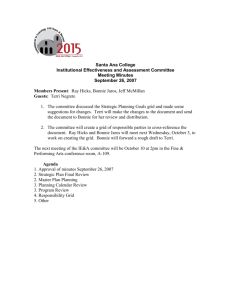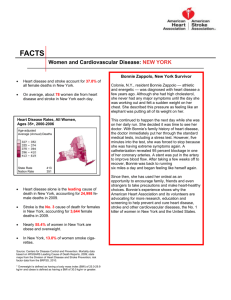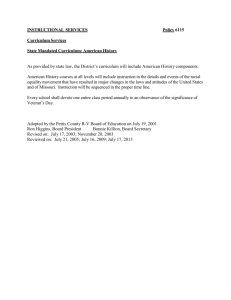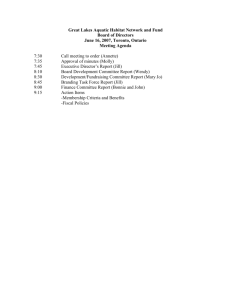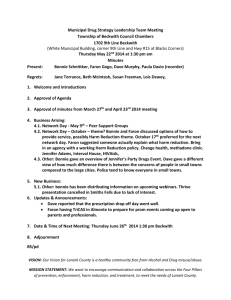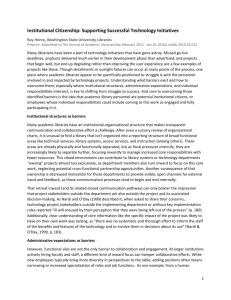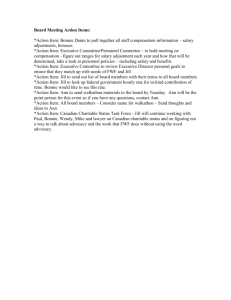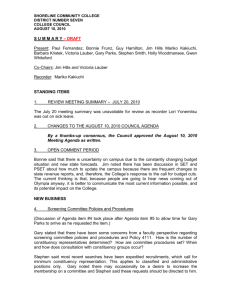PowerPoint file
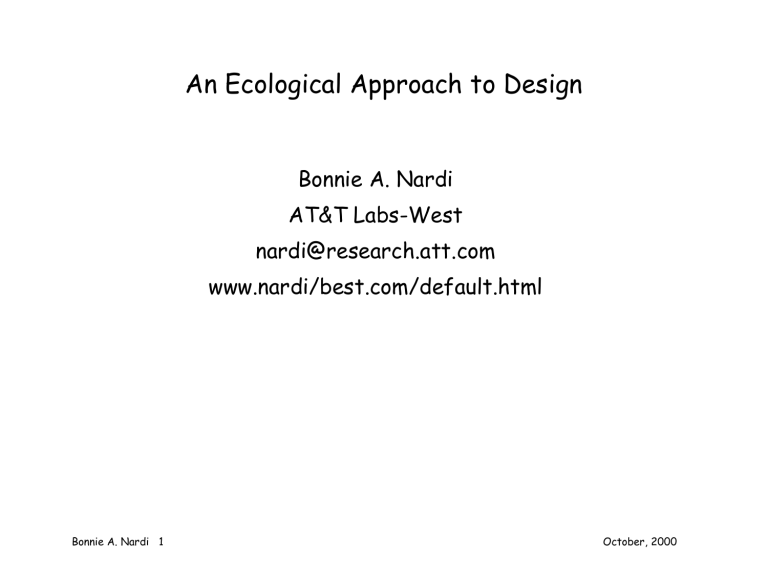
Bonnie A. Nardi 1
An Ecological Approach to Design
Bonnie A. Nardi
AT&T Labs-West nardi@research.att.com
www.nardi/best.com/default.html
October, 2000
Connecting with Our Customers
• Lots of ways:
– surveys
– focus groups
– logging phone, internet use
– lab-based experiments
• Useful for many purposes, but don’t impart a sense of users’ everyday experience and context
• Ecological design
– users in their native habitats
– what problems and opportunities might we find out about?
Bonnie A. Nardi 2 October, 2000
This Talk
• Discussion of ecological design, esp. ethnographic methods
• Specific application of ecological design:
– the netWORK study
– the ContactMap prototype
Bonnie A. Nardi 3 October, 2000
Ecological Design: Leveraging the Local and the Global
Local: Consider as a single analytical unit, local systems of: people practices technologies values
· e.g., lifelong learning, efficiency, profit, patient care, customer care, privacy, open access to information,.....
· local “ecosystems,” e.g., offices, homes, schools, hospitals...
Global: Consider, as a backdrop, larger socioeconomic context in which people work and play
· trends in global economy and society as they impinge on our customers
Bonnie A. Nardi 4 October, 2000
MIT Press,
1999
Bonnie A. Nardi 5 October, 2000
Nuts and Bolts:
Six Step Process of Ecological Design
1a. Ethnographic studies of user activity
· rich, nuanced, subtle descriptions of activity in local settings
1b. Clues about larger socioeconomic context
2. Analyze data to identify gaps and problems in practice
3. Dream up ideas for technologies/services to meet real human needs
4. Prototype technologies
· diverse ecology of designers
computer scientists, social scientists, artists...
5. Get very early feedback on prototypes
6. Iterate design
Bonnie A. Nardi 6 October, 2000
What is ethnography?
• Most closely associated with anthropology, but also sociology
• Ethnography is an approach for developing understandings of the everyday activities of people in local settings
• Ethnography’s Project: enable conversations across social and cultural boundaries between people quite different from one another
– Us trying to understand our customers
Bonnie A. Nardi 7 October, 2000
Principles of ethnography
• Holism
– focus on relations among activities and not on single tasks or single isolated individuals
– everything connected to everything else
• Natives’ point(s) of view
– how people see their own worlds
– opportunity to engage with customers
• Study people in their native habitats
– e.g., home, office, school, library, hospital, community...
Bonnie A. Nardi 8 October, 2000
Ethnographic Methods
• In-depth interviews in context
• Observation
• Participant-observation
Intensive interactions
Bonnie A. Nardi 9 October, 2000
But there’s no time
• Feed results back to developers as work progresses
• Become part of the cycle of iteration
• Get 4-6 weeks up front to do some initial in-depth work
Bonnie A. Nardi 10 October, 2000
Advantages
• Deeper, more nuanced understandings
• More ecological validity
– Represent what’s really going on in some everyday setting
– What’s meaningful to people
• (disconnect between e.g., survey questions... and how people think about things)
• Respect for complexity of human activity
• Design for human needs; reflect users’ own issues and everyday problems
• Cheaper to do it right the first time
– considering the cost of launching a new product
Bonnie A. Nardi 11 October, 2000
Disadvantages
• Seeing the world in a single grain of sand
– comparative work needed
– build from multiple cases
• Ethnography in a mobile, distributed world
– it’s easier when the natives sit still, but we have to modify our methods and perspectives...
Bonnie A. Nardi 12 October, 2000
The NetWORK Study and ContactMap:
• Work undertaken jointly with
– Steve Whittaker - AT&T Labs-Research - Florham Park,
NJ
– Ellen Isaacs - AT&T Labs-Research - Menlo Park, CA
– Rebecca Nagel, AT&T Labs, Menlo Park, CA
– Heinrich Schwarz - Science, Society and Technology, MIT
– Erin Bradner - University of California, Irvine
– John Hainsworth, Princeton University
– Mike Creech, Jeff Johnson (independent consultants)
• Perspectives: psychology, anthropology, computer science, art
Bonnie A. Nardi 13 October, 2000
Step 1a.. Ethnographic Study of Communication
Activity Across Organizational Boundaries
• Beyond teams
– Customer-vendor relationships
– Partnering, alliances across companies
– Facilitators between and within organizations
– High level managers
– Experts, e.g., patent attorneys, reference librarians, HR
– Contractors, consultants
Bonnie A. Nardi 14 October, 2000
Methods
• Lengthy open-ended audiotaped interviews
– 1000 pages transcript
• Questions:
– What do you do?
– Who do you do it with?
– What technologies do you use?
• Observations
Bonnie A. Nardi 15 October, 2000
Sample: 22 People in 12 companies
• Public relations
• Law
• Management
• Creative media (Web design, commercials)
• High tech
• Telecommunications
Technically savvy, use lots of technology, work across organizational boundaries
Bonnie A. Nardi 16 October, 2000
Step 1b. Context: The New Economy
• Constant change in organizations
– downsizing, merging, partnering, reorging, outsourcing….
• People’s personal social networks important under conditions of organizational change, instability due to changing nature of global economy
– anchors in people’s worklives, careers
• netWORK
– create, maintain, activate personal social networks
• Networking isn’t new (Webster’s 1940) but intensified in today’s economy
Bonnie A. Nardi 17 October, 2000
Why netWORK?
• netWORK needed to be effective:
– to yourself for career
– to your organization for information gathering and labor recruitment
Bonnie A. Nardi 18 October, 2000
Distributed Work:
Working Across Organizational Boundaries
Temps
Contractors
Customers and Clients
Rest of organization
Home
Team
Consultants
Vendors
Bonnie A. Nardi 19
Outsourced service providers
Funding
Agencies
Venture
Capital
Colleagues in Other
Organizations
October, 2000
Step 2. Gaps and Problems in Practice
• NetWORK a kind of invisible, unaccounted-for work
– not in performance evaluations, workflow diagrams, timesheets, social science theories...
• But users have to devote time and energy to it
• netWORK activities
– create personal social network
– maintain personal social network
– activate personal social network
– control own presence in personal social network
• e.g., am I available, and if so, to whom?
Bonnie A. Nardi 20 October, 2000
Publications
• A Networker’s Work is Never Done: Joint Work in
Intensional Networks. B. Nardi, S. Whittaker, H. Schwarz.
Forthcoming in CSCW.
• Nardi, B., Whittaker, Steve, Schwarz, Heinrich.. It's Not
What You Know, It's Who You Know: Work in the
Information Age. First Monday, May, 2000 (firstmonday.org)
• Know Who You Know, ComputerWorld, September 4, 2000.
– article by Mat Schwartz on ContactMap
Bonnie A. Nardi 21 October, 2000
Specific Problems
• Remembering who’s in the social network
– who they are
– their details
– current whereabouts and activities
• Using multiple communication media easily
• Remembering which documents have been exchanged when
• Remembering task status
• Getting awareness information for non-colocated contacts
– could be next floor or building, or next continent
Bonnie A. Nardi 22 October, 2000
Step 3. Ideas for Technologies/Services:
ContactMap
• Redesign the desktop to reflect people in user’s social network rather than lists, hierarchies, folders
• Visualize the user’s personal social network
– individuals, groups
• Provide unifying interface for communication and information
Bonnie A. Nardi 23 October, 2000
Bonnie A. Nardi 24 October, 2000
Bonnie A. Nardi 25 October, 2000
What You Do in ContactMap
• Initiate communications
– click to dial
– instant messaging
– video
– fax....
• Find documents associated with a contact (to and from)
– email, graphics files, text files, web pages...
• See reminders
• See availability of others (“activity meters”)
• Initially populate ContactMap through analysis of contacts in email folders (maybe later phone logs)
Bonnie A. Nardi 26 October, 2000
Big (ecological) picture here
• Most desktop redesigns don’t consider communication as a central fact of digital life
– document-centric
• Lifestreams (product from Yale research)
• Presto (Xerox PARC)
– but cell phones, pagers, pdas, electronic books, computers are all merging (above only for computers)
– ContactMap intended to integrate (somehow) with other device interfaces
• Our Step 1 research gave us the idea for a nexus where we can meaningfully bring together information and communication, i.e., personal social networks
Bonnie A. Nardi 27 October, 2000
Step 5. Early User Feedback
• Provide easy ways to create user-defined clusters of contacts
– typical clusters are family, friends, project-n, project-n+1, old workplace, old workplace n-1....
Step 6. Iterate..we’re doing this now!
Bonnie A. Nardi 28 October, 2000
Thank you,
Bonnie A. Nardi 29 October, 2000
